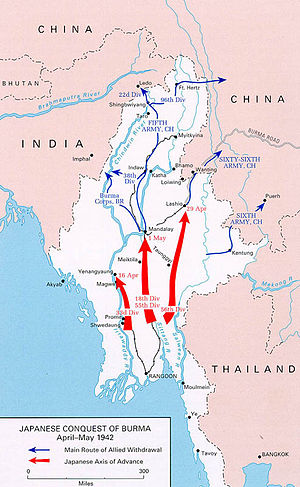
Back Batalla del pont de Sittang Catalan Schlacht an der Sittang-Brücke German Batalla del puente de Sittang Spanish Bataille du pont de la Sittang French Battaglia del ponte sul Sittang Italian
| Battle of Sittang Bridge | |||||||
|---|---|---|---|---|---|---|---|
| Part of the Burma campaign, the South-East Asian theatre of World War II and the Pacific Theater of World War II | |||||||
 Japanese Conquest of Burma April–May 1942 | |||||||
| |||||||
| Belligerents | |||||||
|
|
| ||||||
| Commanders and leaders | |||||||
|
|
| ||||||
| Strength | |||||||
| 1 understrength division | 1 regiments | ||||||
The Battle of Sittang Bridge was part of the Burma campaign during the Second World War. Fought on 22 and 23 February 1942, the battle was a victory for the Empire of Japan, with many losses for the British Indian Army, which was forced to retreat in disarray. Brigadier Sir John George Smyth, V.C.—who commanded the British Indian Army at Sittang Bridge—called it "the Sittang disaster".[1]
The Sittang Bridge was an iron railway bridge spanning several hundred yards across the River Sittang (now Sittaung) near the south coast of Burma (now Myanmar). The 17th Indian Infantry Division had given "everything it had" at the Battle of Bilin River and was already weak.[2] Now in retreat, they finally received permission to withdraw across the Sittang on 19 February. They disengaged from the enemy under cover of night, and fell back 30 miles (50 km) westwards along the track that led to the bridge.
The Japanese 214th and 215th Regiments advanced, aiming to cut the British forces off at Sittang. Lieutenant General William Slim (later Field Marshal Sir William Slim), who took command of the Burmese theatre shortly after the battle ended, called the Sittang Bridge "the decisive battle of the first campaign".[3]